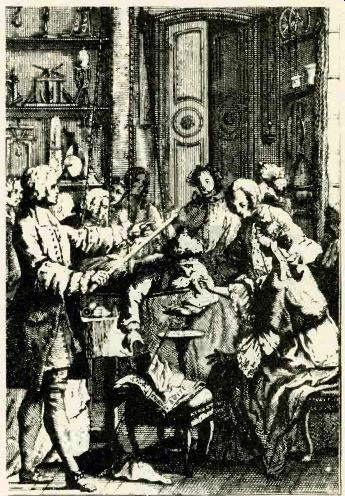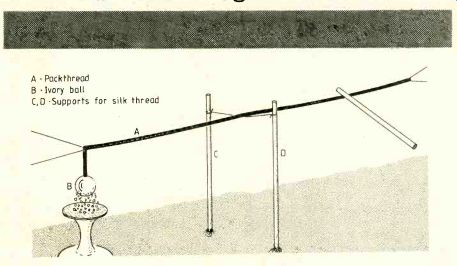In this new series, Tony Atherton recounts some turning points in the development of electrical communications and sketches the personalities who brought them about.
1. Stephen Gray (c.1666-1736): discoverer of electrical conduction.
by W.A. ATHERTON

----------- Gray also found that the human body is a conductor. In this
demonstration, a boy suspended from the ceiling has been electrified
by the glass tube and is showing his powers of attraction.
The discovery of electrical conduction and insulation must rank as one of the most important technical discoveries in history. The names of later pioneers such as Morse, Bell and Marconi are well known to the public, yet the name of the man who took the very first step is unknown even to most electrical engineers.
Scientific breakthroughs are not usually made by gentlemen enjoying a quiet retirement, but the conduction of electricity was indeed discovered by a pensioner: Stephen Gray, by then ten years into his retirement.
Knowledge of electricity was primitive in the early 18th century. From ancient times it had been known that if amber was rubbed with fur, for example, it would attract small, light objects (such as a feather) to itself. This discovery of electrostatic attraction, the first discovery in electrical science, is still remade daily, usually by young children wielding plastic combs. William Gilbert (the founder of magnet ism as a science) in 1600 announced other materials possessing the same property and gave them all the collective- name of electrics, from the Greek name for amber. We now call them insulators. Anything else was a "non-electric".
By 1700 progress had occur red. Otto von Guericke in Ger many had made a spinning ball of sulphur, which if allowed to rub against the hand would build up a sizeable static electric charge.
It is now acknowledged, as the first electrical machine. Magnetic and electrical phenomena were known to work in vacuum as well as in air, and electrical glow discharges in vacuum--the first electric light--were being studied.
Such was the state of what would eventually be called electrostatics with which Stephen Gray became familiar as he took to the fascinating pastime of electricity. Whilst living in Cambridge he had assisted the first Plumian professor of astronomy and experimental philosophy and he had given a few electrical demonstrations. He had also learned of what for 40 years or so was to become the standard method of producing static electricity- vigorously rubbing a long glass tube.
In 1719 Gray became a pensioner at the Charterhouse, a London institute for retired gentlemen, and soon after he started the work for which he is remembered more than 250 years later. In one writer's words, he began "that justly celebrated series of experiments which...only ended with his last breath in 1736." He even dictated an account of his final experiments to the secretary of the Royal Society of London the day before his death.
The principle of electrical conduction was discovered in February 1729, a discovery which would lead in the following century to world wide electric telegraphy.
Gray knew that amber, glass, resin and so on (all insulators) could be electrically excited (charged) by the standard techniques of rubbing, hammering and heating; and he had tried, but failed, to do the same thing to metals. It occurred to him that if a glass tube was charged it might be able to pass on the charge (electric virtue, in Gray's words) to the metal. So he tried it.
His glass tube was 3ft 5in long, had a bore of one inch, but was larger at the ends than in the middle. (I often wonder if it was a yard of ale!) He capped the ends with corks to keep out the dust, but the corks as it turned out did more than that.
The first experiment was to check whether the corks affected the power of attraction of the tube. They did not, but...
"I then held the feather over-against the flat end of the cork, which attracted and repelled many times together: at which I was much surprised." The corks were electrified. The glass tube had passed on the "electric virtue" to the corks!
GRAY PURSUES HIS DISCOVERY
A four-inch long fir stick was next stuck into a hole in an ivory ball and the other end Cray fixed into the cork. Both the cork and the stick conducted the electricity and the ivory became charged.
The same thing happened with an eight-inch stick and with a 24-inch one, and with brass wire and iron wire. Finally he tied the ball to a length of packthread (strong string) and hung it directly from the glass rod. It worked! As the string got longer Gray ran out of height in which to experiment and so was forced to lay the string horizontally. To prevent it from touching the floor he sup ported it with another piece of packthread tied to a nail driven into a beam. Alas when the glass tube was charged nothing happened to the ivory ball. The experiment had failed and he correctly deduced that the charge had escaped up the vertical string, through the nail and into the wooden beam.
Further experiments were then postponed. Working horizontally had failed and he determined to pursue the matter with even greater lengths of string held vertically, which he felt sure would work. He even dreamed of trying the experiment "...from the top of the cupola of St Paul's, not doubting but the electric attraction would be carried perpendicularly down from thence to the ground." By late June, Gray was demonstrating his experiments to Granville Wheler (1701-1770) at Wheler's country house; and Wheler, an accomplished "electrician", was soon accompanying Gray in extending the work.
The greatest height they could achieve was a 34 feet drop from the clock turret of the house, a distance through which the electricity was conducted with ease.
Gray then tried again to lay the string horizontally, this time using silk supports at Wheler's suggestion. Gray thought it a good suggestion since the silk was so much thinner than the packthread "...there would be less virtue carried from the line of communication." The concept of two classes of materials, conductors and insulators, was then un known (though not for much longer) and there was therefore no idea that silk is an insulator.
The experiment was tried at 10a.m. on July 2,1729 and was a great success. The line was 80 feet long and was soon extended to 147 feet by doubling it back on itself. The charge was transmitted from a glass rod through the packthread to the ivory ball which promptly displayed the property of attraction, the then one sure test for the presence of electricity.
Next morning the line was extended as far as 293 feet before the extra weight broke the silk supports. Stronger supports were needed. Fine brass wire was substituted for the silk. It was stronger but very thin and, to their thinking, this thinness meant it would be as good as the silk at stopping the electricity from escaping.
The experiment of course failed. No electricity was conducted to the ivory ball, which gained not the slightest power of attraction.
All the charge escaped via the brass wire supports, despite their fineness.
The friends now realised that the critical consideration was not the thickness of the supports but the materials from which they were made. Silk prevented the electricity from escaping, packthread and brass wire did not. The phenomena of conduction and insulation were now apparent.

----- Gray's crucial experiment: electricity was conducted
from the charged glass rod (right) to the ivory ball. Though neglected
in our own time, Gray and his achievement were recognized by some, at
least of his contemporaries: in 1732 he was elected a fellow of the Royal
Society.

This eulogy, published in 1766 in Miscellanies in Prose and Verse, is
by Anna Williams, who knew Gray during his time at the Charterhouse and
whose father was also a pensioner there. The copy is now in the British
Library.
A 54-page illustrated article, The Enigma of Stephen Gray by David H. Clark and Lesley Murdin of the Royal Greenwich Observatory, appeared in Vistas in Astronomy, 1979, vol.23 (Pergamon Press).
==============
It was soon clear that all materials (or so it seemed) could be classified as behaving either like silk (insulators) or brass (conductors).
Gray prophetically termed his conducting thread a "line of communication". A little later J.T. Desaguliers, with whom Gray had once lived, suggested the terms insulator (from the Latin for island) and conductor.
Previously the only words had been Gilbert's "electric" and "non-electric".
Gray and Wheler used their new-found knowledge to extend their maximum distance to 765 feet in July and to 886 feet in August. The basis for electrical communication had been laid- but not yet recognized.
In France, Charles du Fay (1698-1739) confirmed and extended Gray's discoveries and found that metal wire and moist string worked even better than packthread. He went on to realize that there are two fundamental types of electricity which he called vitreous and resinous (amber is a resin).
Benjamin Franklin eventually gave them the easier but less imaginative names of positive and negative.
Gray meanwhile had found that the human body makes a nice conductor, as anyone who has touched the live mains will confirm.
In doing this he suspended from the ceiling a young (and probably rather frightened) boy.
He was strung up by insulating cords and laid horizontally, face down. Gray electrified him by holding a charged glass tube near his feet and noted that metal leaf was then attracted to the boy's face. Du Fay repeated the experiment and even suspended and charged himself.
The experiment was repeated in Germany in about 1743, the same year in which Georg Boze in Leipzig amused himself and others by charging pretty girls and daring young men to kiss them. The shock, it was said, broke their teeth.
Gray had also found in 1732 that the effect could be passed from one boy to another if they held hands or were linked by a conductor. After the invention of the Leyden jar in 1745 (the first storage capacitor) the Abbé Nollet in France persuaded 180 Royal Guards to link up and act as a conducting path through which he discharged a fully charged Leyden jar. Not surprisingly all 180 guards leapt into the air simultaneously. He next formed a circle of 5800 feet consisting of Carthusian monks linked together with iron wire. Again their vigorous reactions were simultaneous.
The object of these strange experiments was to determine the speed of transmission of the electricity. It was apparently instantaneous.
Two years previously J.H. Winkler, a German physicist, concluded that the speed was comparable with that of lightning and it could be transmitted to the ends of the Earth.
In the following century it was.

Tony Atherton works at the Independent Broadcasting Authority's Engineering Training College in Devon. His book, "From Compass to Computer, A History of Electric al and Electronics Engineering" was published by Macmillan Press in 1984.
Hans Christian Oersted, discoverer of electromagnetism, will be the subject of the next article.
------------
==========
(adapted from: Wireless World , Jan. 1987)